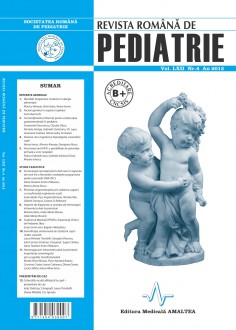SELECT ISSUE

Indexed

| |

|
|
|
| |
|
|
|

|
|
|
|
|
|
|
HIGHLIGHTS
National Awards “Science and Research”
NEW! RJP has announced the annually National Award for "Science and Research" for the best scientific articles published throughout the year in the official journal.
Read the Recommendations for the Conduct, Reporting, Editing, and Publication of Scholarly work in Medical Journals.
The published medical research literature is a global public good. Medical journal editors have a social responsibility to promote global health by publishing, whenever possible, research that furthers health worldwide.
PERI-INTRAVENTRICULAR HEMORRHAGE IN PRETERM INFANTS: THE IMPORTANCE OF SCREENING BY TRANSFONTANELLAR ULTRASOUND
Mirela Elena Ritivoiu, Florin Nicolaie Brezan, Cosmina Cristea, Ioana Codreanu, Diana Goran, Lucica Ghita and Ioana Alina Anca
ABSTRACT
Objectives. In preterm babies, peri-intraventricular hemorrahges (PIVH) might cause various degrees of neuropsycho-motor impairment. A 4-year prospective study (2009-2012) performed in the IOMC, was aimed to determine the prevalence of different degrees of PIVH diagnosed by head ultrasound (HUS) among 160 admitted preterm babies, the associated risk factors, along with the neuro-developmental effects on a 12-month follow-up period.
Material and methods. In the above-mentioned period all admitted preterms were examined by transfontanelar ultrasound according to a standardized protocol based on Papile’s PIVH classification. For those preterms included in the study a 12-month systematic neurologic follow-up was performed. Results. PIVH grade I (45%) and II (37,5%) were the most prevalent types. Grade IV PIVH represented 4,4% from all PIVH cases. The good neurological outcome of grade I and II PIVH, was found to be statistically significant (p < 0.01) for both types. Severe neurological sequelae were associated with grade III and IV and a statistically significant correlation (p<0.01) was found only for grade IV hemorrhages.
Conclusion. Systematic HUS screenings for all preterm babies is useful for early diagnosis and PIVH staging, for neurologic outcome prediction, providing the appropriate management strategy and a well-suited parental counseling.
Key words: preterm, transfontanelar ultrasound, peri-intraventricular hemorrhage, neurological outcome
